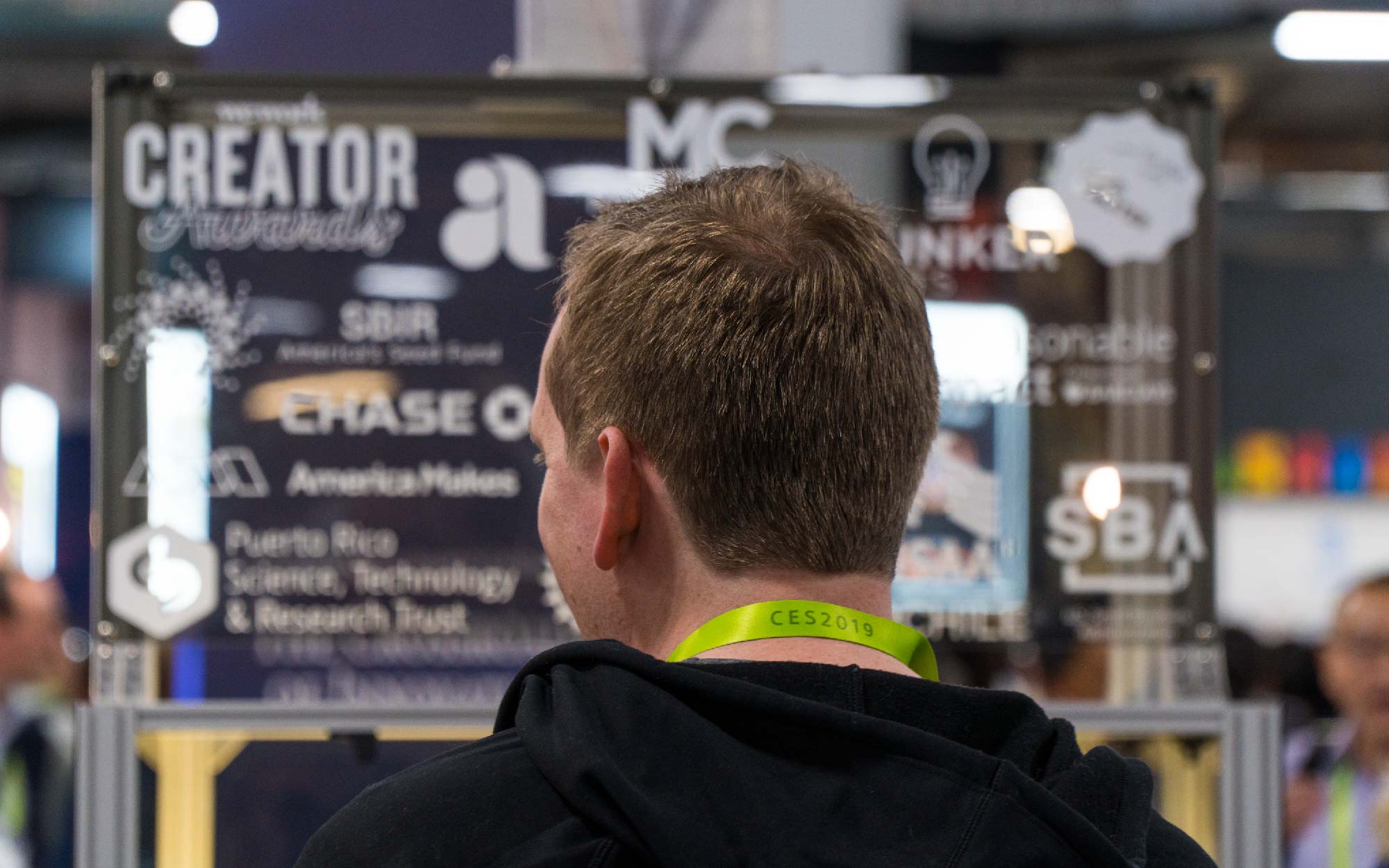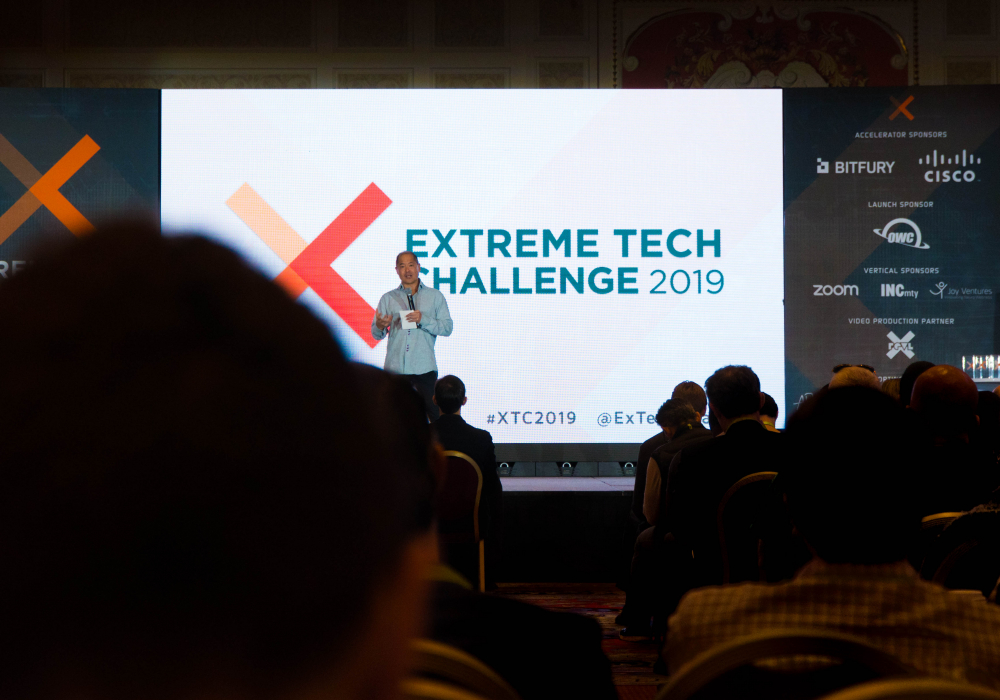Read how 3D printing created a solution for the community after Hurricane Maria in Puerto Rico.
Continue readingConvening Global Community: Thank You CES 2019
CES 2019 was jam-packed with activities and innovations that sprawled throughout Las Vegas with over 180,000 attendees, exhibitors, and speakers. The conference and exhibition activates across giant venues in Las Vegas including The Venetian, Sands Expo Center including startup innovation arena Eureka Park, and the Las Vegas Convention Center. Companies and innovators on the spectrum of industries and size exhibited their latest work, from life-size drone helicopters, robots beating humans in ping pong, pretty much anything “smart” you can imagine or yours truly, showing our large scale 3D printer printing from plastic waste. We posted some insights on our schedule and first day at CES and here is the remainder of our insights, adventures, and recap of our first CES experience. All in all, CES was about convening community from around the world to showcase and connect over their latest innovations and we wanted to write a recap and thank you note to our community who have supported ours.

Our debut at CES 2019 wouldn’t have been possible without instrumental partners who gave us platforms to exhibit our new technology, Gigabot X. Gigabot X is a large scale (or large format if you prefer), affordable 3D printer printing from pellet or flake plastic. Pellet printing in and of itself drastically lowers the cost to 3D printing 10 times and prints up to 13 times faster than other printers. Even more so, after various peer-reviewed research with Michigan Technological University – Gigabot X has been validated printing from multiple types of plastic waste in pellet and flake form. To showcase these developments almost exactly a year after we won the WeWork Creator Award and received funding from the NSF SBIR Phase I grant as well as launched Gigabot X on Kickstarter, it was a huge privilege to have our hard work on display to the global community who convenes at CES – meeting industry leaders, makers, fellow creators, and enthusiasts from all over.

We also exhibited some Gigabot X and Gigabot prints such as 3D printed coral (straight from 3D scans of the Caribbean), a skateboard 3D printed from recycled plastic, vases, trashcans, architectural pieces, our infill educational tool, 3D printed medical devices, coffee picking baskets, prosthetics, replacement parts and more real-world examples of the innovations around the world, across industry, all with the commonality of solving problems utilizing Gigabot and 3D printing technology . While we’re putting the final touches on Gigabot X before it’s commercially available, the positive feedback, inquiries, and pre-orders of Gigabot X were a major accomplishment of our time during CES. However, as a community-driven organization, this latest accomplishment wouldn’t have been made possible without a world of supporters (yourself included) and some of the major supporters who have gotten us to where we are today. This gratitude was proudly broadcasted across Gigabot X’s headboard (see below photo). Beyond that, we wanted to write a recap and thank you note to CES and those who made it possible for us to be at CES, get to CES and showcase our vision.

Thanks to National Science Foundation, Small Business Innovation Research, and Small Business Association not only for making the NSF SBIR grants available like the Phase 1 grant that helped make Gigabot X a reality but also for the support and partnership to showcase Gigabot X at the U.S. Government Startup connection booth in Eureka Park and ongoing support. We also got to meet other amazing organizations co-exhibiting in the U.S. Government Startup Connection booth like Ampaire on a mission to provide the world with all-electric powered commercial flights that are affordable, quiet and environmentally conscious, and Hivemapper, Learn With Socrates, and Gen X Comm. Despite the government shutdown which created some curveballs, our partners at NSF and SBIR were integral to our CES presence and getting to debut Gigabot X to the community. Thanks to USPTO for being there!
Gigabot X's headboard thanking WeWork, Bunker Labs, MassChallenge, Alice, Chase, SBA, SBIR, Unreasonable, USAA, Startup Chile, PRSTR Trust, Parallel18, NSF, America Makes, Kickstarter & others who made it possible!
Connecting with WeWork and their Senior Construction Partner, Brian Ringley, at CES was another major milestone. The one year anniversary from when we won the $1M WeWork Global Creator Award occurred during CES and on the same day at CES, Brian met his new Gigabot X heading his way, one of the first to be delivered to Kickstarter backers from the successful launch last year. It was an amazing time to connect with Brian and celebrate this full circle collaboration: from winning the WeWork Creator Award to launching the Gigabot X prototype on Kickstarter to working together on Gigabot X’s the evolution from a beta bot to delivering it in person on perhaps one of the biggest platforms and convenings for electronics. We also got some great snapshots with Brian’s first print and his kickflips on our 3D printed skateboard from recycled plastic!

Taking the stage as a top 10 finalist in Richard Branson’s Extreme Tech Challenge was another major highlight of our CES experience. We have so much gratitude and admiration for Richard Branson, the other companies in this competition, the judges who gave us feedback, and the team from Extreme Tech and Actai who have supported us along the way. Making the top 10 of this global competition was a huge honor for us and we extend a huge congratulations to the top 3 winners from Lynq, Elevian, and Active Protective who won a trip to Necker Island as well as other semi finalists who received a surprise invite to Necker along with us! We look forward to future collaborations with this community and grateful for the stage and the setting to share our vision and demo Gigabot X.
Judges: Dave Hagan, CTA; Lisa Andrews, Ignite Alliance; Veronica Serra, Pacific Investimentos & Innova Capital; Shankar Chandra, Samsung Catalyst Fund; Larry O'Connor, OWC. #XTC2019 Companies: re:3D, Last of Ours, We Walk, Liven, Nyx Technologies, Active Protective, Elevian, Lynq, Einride, Bitlumens, Civic Eagle
Techstars likewise gave us a great platform on their #StartupStage to share our innovations in the robotics pitch competition in Eureka Park. After being selected as a top 10 from a number of applicants, we competed with a 60 second pitch and were humbled to take home 1st place and meet creators of cutting edge robotics and judges from Misty Robotics and Lynq.

If you know our story, you know it begins with Kickstarter – and Kickstarter continues to be a key community partner and powerful platform that supports us as we launch new evolutions of the Gigabot family such as Gigabot X last year to its first beta users. We were grateful to meet with the Kickstarter team, like Clarissa, and community at some amazing meetups after hours with a global network of creators and partners like Hackster and Dragon Innovation.
We are forever grateful for our friends and supporters who have gotten to where we are today! Arguably one of the proudest highlights of CES was reuniting with one of the first Gigabot owners, Doug Mockett of Mockett, who came to say hi to us at CES from California. Still to this day, their two Gigabots run around the clock and they lovingly call them their “workhorses”. We met up with some other customers (like one using Gigabot to 3D print entire life size inventory robots) and even suppliers like LDO Motors.

We got to catch up with friends from former accelerators like Waverly Labs from Startup Chile, our first accelerator we joined when we launched in 2013. We met up with one of our mentors from Parallel 18, Alicia Syrett. We also said hi to fellow Unreasonable Impact alumni on a mission to create solutions and jobs in the green economy such as the teams from Heatworks and Breezometer exhibiting in Sands Halls.
We spent one morning getting to tour the local Afwerx office in Las Vegas, an organization creating innovative and crowdsourced solutions for the most critical problems affecting those in our Air Force and an organization especially close to our heart with two teammates Samantha and Kara actively involved in the military and Air Force. We also got to see our partners at IEEE and Finn Partners at an evening event, some great partners who share aligned values with their mission to foster technological innovation and excellence for the benefit of humanity.
A huge thank you as well to partners and press who acknowledged us in their pieces, we can’t say enough how grateful we are for your recognition. Alice’s Elizabeth Gore included us in an Inc article with a major announcement on the bright future of diversity in tech, Jean Baptiste Su noted us in Forbes top 22 innovative technology startups to watch at CES and Beau Jackson’s 3D printing round-up at CES in 3D Printing Industry gave us a nod. Thanks for these platforms and writers for sharing our story! We hope to continue to share more on our developments, diversity, and problem solvers around the world breaking limitations with 3D printing.
We are so grateful to CES for giving us a big platform to jump off of in 2019 as we dive into a year filled with new innovations, stories and leaps forward toward a world empowered by sustainable and locally driven manufacturing. Thank you and stay tuned for some more updates and footage coming your way. Don’t forget: #ReduceReuseRe3D
p.s. If you were following our road trip to CES and are curious about the adventures of re:3D after official CES festivities, we packed up Gigabot X in our beloved Uhaul and headed back to Texas the way we came: 1,500 mile road trip. We traversed from Las Vegas to Tucson, then on to El Paso where w dropped off a Gigabot at the University of Texas El Paso's W.M. Keck Center for (extremely rad) 3D Innovation in partnership with America Makes. We then took a break to rock climb at McKelligan Canyon in El Paso before heading back to Houston, Austin & San Antonio.
Cat George
Blog Post Author
Insights & Adventures From CES: Day 1
The first 24 hours in Vegas have been a thrill and day 1 at #CES2019 has been full of adventures.

3 years ago… re:3D co-founders kick it with founder of Zappos Tony Hsieh at his Downtown Container Park.

The Eve of CES, our heroic quartet of re:3Ders who road tripped from Houston to Vegas rolled in and brought Gigabot X straight to the founder of Zappos Tony Hsieh’s Downtown Container Park, Bin 702 for Gigabot X’s Las Vegas debut over a small dinner and drinks (and occasional background ambience of Downtown Park’s epic fire breathing praying mantis). Amazingly, this location Matthew & Samantha met Tony 3 years ago when the vision of Gigabot X is still in its beginnings.
CES Kicks Off… Gigabot X at Sands Expo Eureka Park Booth #51510

Day 1 kicked off with an early load in to Sands Expo and getting Gigabot X to our booth at Eureka Park (meet us at #51510!) – where we are co-exhibiting at the U.S. Government Startup Connection booth in thanks to our partnership with National Science Foundation and Small Business Administration after receiving the NSF SBIR Phase 1 grant last year. This grant was instrumental in making Gigabot X a reality. There are also so many partners and supporters we owe huge gratitude to for making Gigabot X come to life and we’re proud Gigabot X’s top panel displays all their logos (more high res photos coming soon =).
Gigabot X – our large scale, affordable 3D printer that is printing from multiple types of plastic waste – is exhibiting in Eureka Park, Sands Hall G Floor 1 Tech West Booth #51510. After receiving the NSF SBIR Phase 1 grant this year, we were privileged to be invited as one of a handful of startups to co-exhibit at the U.S. Government startup connection booth. That said, the recent government shutdown has shaken a few things up and though our friends from NSF and SBA can’t be here, we’re still here and printing – so tell your friends to drop by!

re:3D Wins Techstars #StartupStage Robotics Pitch Competition!
Samantha Snabes hit the #StartupStage powered by Techstars for their robotics pitch competition where 8 companies did a 60 second pitch followed by 3 minutes of Q&A from Karina Costa of Lynq, Ian Bernstein of Misty Robotics, Silas Adekunle of Reach Robotics and Tyler Mantel of Watch Tower Robotics.
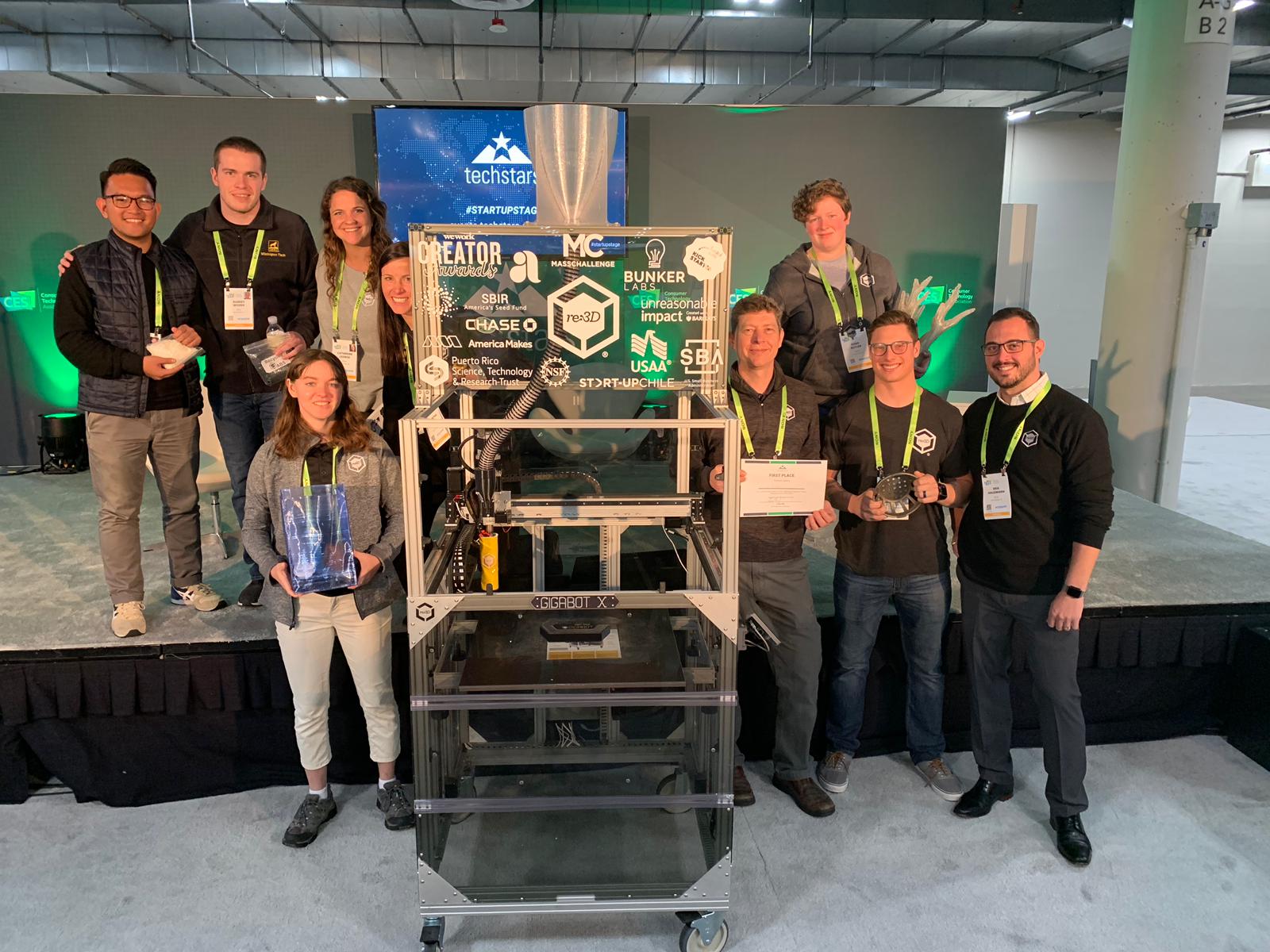
The line up was fueled by entrepreneurs with amazing entrepreneurs and innovations in robotics, but Samantha and Gigabot X took gold with 1st place! Thanks Techstars for inviting us to this pitch competition and we were excited to snap a pic with Karina who is a fellow finalist for Richard Branson’s Extreme Tech Challenge where the finals will commence on Thursday at the Venetian Bellini Ballroom 2003-2006 from 12-3pm (come see Gigabot X product demo from 12-1pm)

A Giga Reunion with Doug Mockett of Mockett & Friends
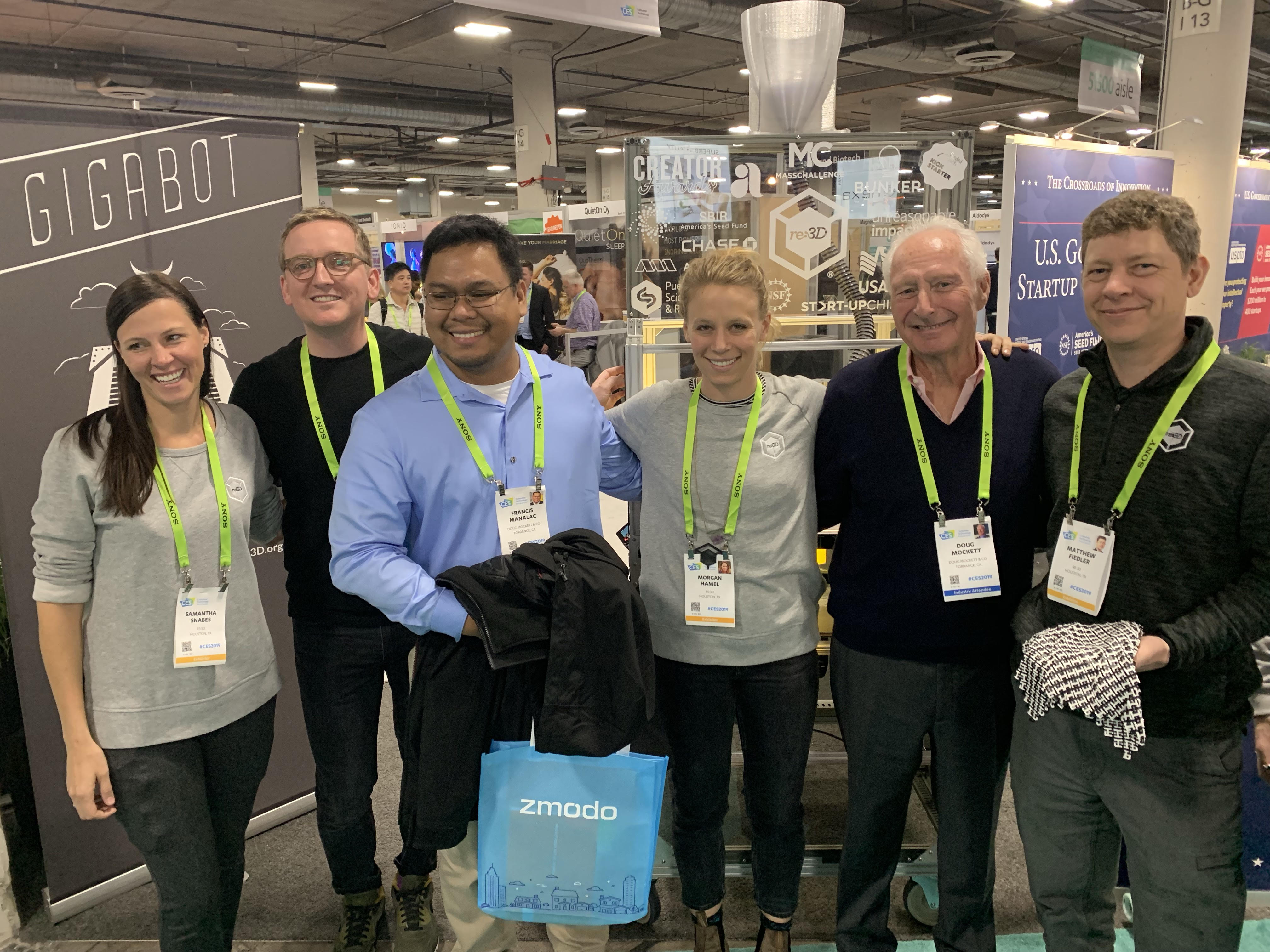
We were overjoyed to catch up with one of our first customers and long-time Gigabot owner, Doug Mockett of Mockett, who stopped by from California to say hi and meet Gigabot X. We love nothing more than to connect with our customers in over 55 countries, if you’re at CES – come find us!

After official CES activities closed at 6 pm, we headed to Tao Restaurant to meet with our friends at Finn Partners who partner with IEEE to share amazing stories of technological innovation and excellence for the benefit of humanity. Samantha and Matthew bring their diverse expertise, talents, knowledge, and know-how as technical experts!
After official CES activities closed at 6 pm, we headed to Tao Restaurant to meet with our friends at Finn Partners who partner with IEEE to share amazing stories of technological innovation and excellence for the benefit of humanity. Samantha and Matthew bring their diverse expertise, talents, knowledge, and know-how as technical experts!
Making A World Record & Having Some Fun Escap-ades at Escapology
Our troop of 13 re:3D teammates headed to Escapology after CES festivities to divide and conquer two different escape rooms. Team Knotnauts set a world record escaping the Under Pressure room in 40 minutes and 56 seconds. Team Awesome followed close behind, finishing (the arguably harder 😉 Budapest Express in 45 minutes. Let’s be real though, in this fun scenario, everyone won =).
Team Knotnauts Pose For Paparazzi After Setting Escapology World Record
Cat George
Blog Post Author
Roadtrip: CES 2019!
On the road to CES 2019! Here’s our schedule.
Continue readingHiveCube: Building a Safer Future for Puerto Rico
Note: re:3D does not manufacture HiveCube homes, but rather was part of the prototyping process and helped to 3D print architectural models which HiveCube used for pitching to investors.
Maria Velasco was hunkered down with family on the west coast of Puerto Rico in Mayagüez when Hurricane Maria hit.
“The first 24 hours there was no contact with anything outside of your neighbors.”
She described how, in the immediate aftermath of the storm, they could venture a little further from home each day to assess the damage. Families relied on word of mouth to check the wellbeing of their loved ones; people would drop by to let others know they were alive.
“It’s a humbling experience,” Velasco recounts. “You realize what you need and what you don’t need in life.”
It was this focus on the essentials in a time of crisis that got Velasco and her business partner, Carla Gautier, thinking. Channeling the spirit of resiliency on the island following the disaster, Gautier and Velasco vowed to stay and help rebuild in their own way, to make the future safer for the people of Puerto Rico.

The Beginnings of the Hive
Gautier has a particular skillset that makes her well-suited for the challenge: she’s an architect.
While completing on her Bachelor’s of Science in Architecture in Boston, she spent four months in Berlin, traveling around Europe to study alternative types of architecture for low-income communities. It was on this tour that she was first exposed to structures made from shipping containers. Later, during her Masters of Architecture, she spent time in West Africa – in Benin – studying informal construction and development.
These two exposures later came together to form the foundation of HiveCube.
After completing her master’s, Gautier started working for FEMA, getting an up-close view of the destruction around the island post-Maria. On this assignment, Gautier saw firsthand a major factor that compounded the destruction of the storm: buildings not being up to code.
She and Velasco did some research, discovering that 55% of housing in Puerto Rico is constructed informally. Some areas of the island may not have stood a chance against the force of Maria, but surely structures being built to code and with hurricanes in mind should be a given on the island, the pair mused.

These three experiences in Gautier’s architecture career – her work on low-income housing in Europe, her study of informal construction in West Africa, and her exposure to the prevalence of informal construction on her home turf – came together to form the seed of an idea.
Gautier wanted to bring her knowledge of simplistic yet effective designs for low-income housing from Europe to help people in her homeland, to create affordable housing built to withstand ferocious storms that didn’t compromise on quality or comfort.
The idea for HiveCube began to take shape.

A Jumpstart from Parallel18
Hurricane Maria tested the resiliency of Puerto Rico, and Puerto Rico stepped up to the challenge.
San Juan-based startup accelerator Parallel18 created a new program post-Maria specifically to harness the energy and drive to bounce back that they saw amongst the population. Called Pre-18, it was a separate entity from their typical accelerator program, where they mentored around 40 companies from Puerto Rico each working in their own way to rebuild and kickstart the economy after the storm. HiveCube was one of the companies accepted.
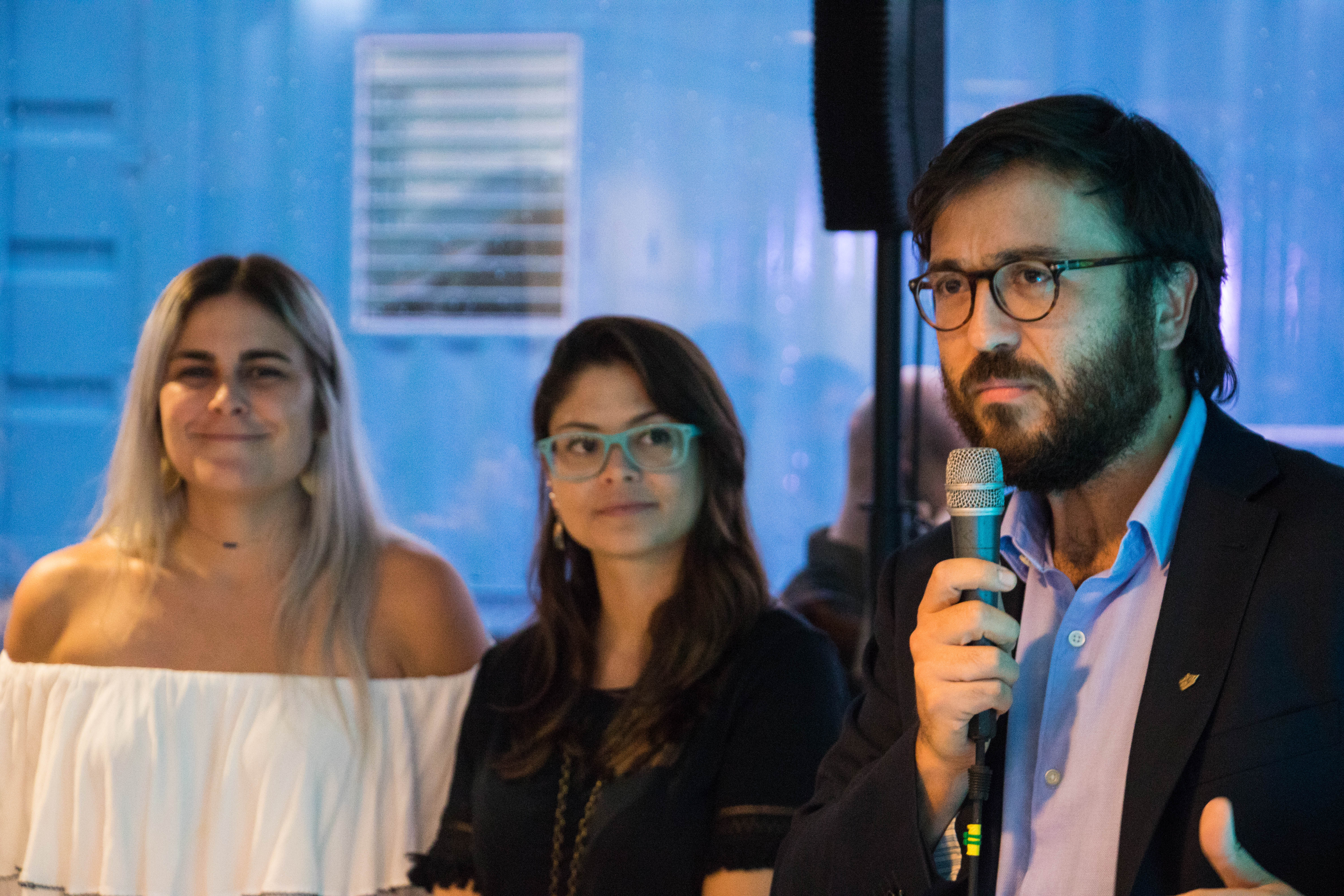
HiveCube and the other companies of Pre-18 epitomize the buoyant spirit of Puerto Ricans following one of the worst disasters on the island in recent history.
“We had our campaign called ‘El Boricua se las Inventa’ – Puerto Ricans Get Creative,” explains Arzola. “We’ve seen that creativity happen all around us, and HiveCube is just one example of a company that was born from the hurricane and created a solution that now is growing and thriving.”
Companies from the Pre-18 program were then eligible to be selected for the following Parallel18 cohort; HiveCube was one of 16 that made this jump. “We’ve never as many Puerto Rican companies in the Parallel18 cohort as we did in this one,” Arzola muses.
The Pre-18 program was so successful that Parallel18 has decided to make it a regular thing. “It’s going to be an official program we’re going to do once a year,” explains Arzola. “So the idea is that we can do one Pre-18 cohort for every two Parallel18s.”

HiveCube’s extended time with the Parallel18 team super-charged their pace of progress as well as reinforced the value of the accelerator program.
“We’ve seen them evolve and grow significantly in a short amount of time, so it sort of validates our program as well,” says Arzola. “There’s no better validation than just seeing thriving companies that will be able to contribute to Puerto Rico and grow from this point on, because we’re able to support them in this stage where they need help the most. That’s why we do what we do.”
Parallel18 is also where Gigabot enters the HiveCube story.

The duo was having a tough time pitching investors: their vision was getting distorted along the way, often manifesting in others’ minds as a less-aesthetic, lower-quality “trailer.” But what the two had in mind was so much more – they just couldn’t figure out how to communicate this in a way that resonated with prospective investors.
Gautier and Velasco experienced firsthand the phenomenon of using a 3D printed prototype in lieu of a digital one. The digital renderings on a computer screen or projector weren’t getting them the reactions in meetings that they wanted, but perhaps a physical model could convince people of their vision, they thought.
They used Gigabot to print a basic architectural model of a Hive, and began taking it to meetings with investors and communities working on reconstruction. The physical model excited people in a way that digital drawings and renderings hadn’t.
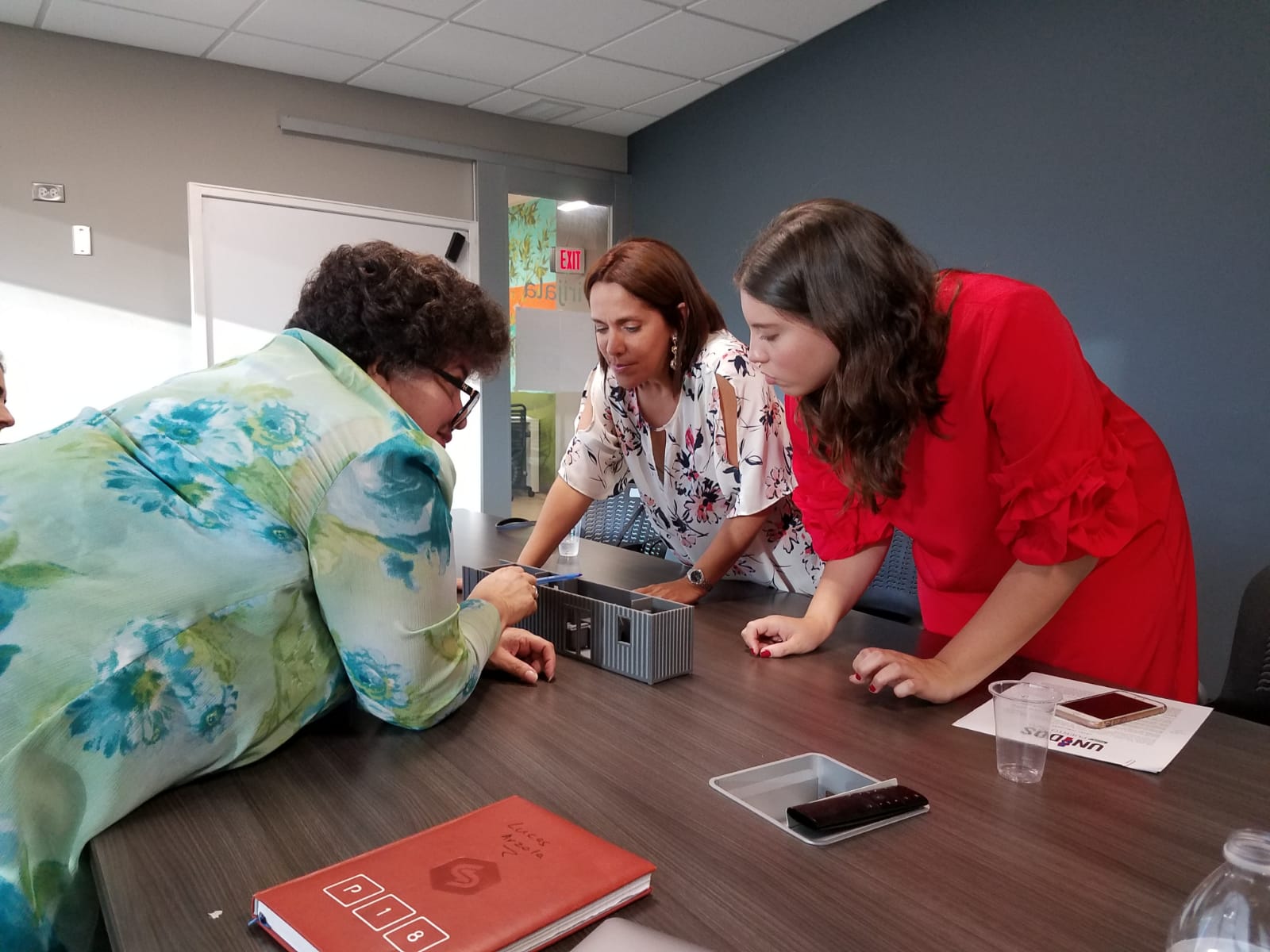
Suddenly, in Velasco’s words, “everybody wanted to take the meetings, everybody wanted one.”
There was something about being able to turn a physical object over in their hands that clicked with people. The surge in enthusiasm over the model pushed the pair to continue driving forward and make the concept a reality. With the first hurdle crossed, they now had to bring their vision to life.

Building a Hive
HiveCube works with used shipping containers, lending a second life to structures that would otherwise end up in container graveyards.
They buy a certified-as-seaworthy shipping container, verify that the container is structurally sound, and begin preparing it for its new life. The container is given holes for windows and a door, a fresh coat of paint, and the interior refurbished and outfitted with living fixtures.

The prototype Hive that they constructed for their August launch party is what will become their Basic Model: a two bedroom, one bathroom unit with a kitchen and living room in the center.

They’re filling a major gap on the island that contributed to the devastation caused by Hurricane Maria: creating housing that’s code-compliant but also affordable for the general population.
“We believe in their concept: the fact that they’re bringing an architecture background to what they’re doing and are designing hurricane-resistant homes that can provide accessible housing,” Parallel18’s Arzola explains. “That’s really relevant to one of the big problems that appeared after the hurricane: the fact that the median income in Puerto Rico is low compared to the cost of housing. There is a need for more affordable options in the market.”

Their goal is to create something that’s more than just a safe shelter. “We’ve been trying to make sure that we build something that’s actually nice to live in, not just something cheap and fast,” Velasco explains. “Something that people would want to own and they’re proud of and that they feel comfortable and safe with.”

The pride for their island shines through HiveCube’s mission to create safe, affordable housing for Puerto Ricans.
As Velasco puts it, “We’re going to try and build something that can actually help the community be stronger, if something like this – God forbid – happens again.”
On December 13th, HiveCube took home the People’s Choice Award at Parallel18’s Generation Five Demo Day, an award bestowed by an audience vote.
“It speaks to how relatable and relevant the solution is to Puerto Rico,” muses Arzola. “So yeah, we’re very proud.”
Morgan Hamel
Blog Post Author
The Power of Printing With PETG
We’re excited to now sell PETG at re:3D! Why do you ask? I sat down with Co-Founder and Head of Technology, Matthew Fiedler, for some Q&A on the power of 3D printing with PETG. Read below, check out some video footage of how we are using PETG at re:3D and tune into our inaugural Meet with a 3D Printing Engineer live session next week no matter where in the world you are to chat with our 3D printing engineers live and bring any questions you may have.
Why is re:3D releasing and deciding to sell PETG now?
“Polyethylene terephthalate Glycol is an interesting material for FFF AM because of the enhanced material properties compared to the most common filament, PLA. PETG exhibits high layer to layer bonding strength, slightly elevated Tg of 80C over PLA which has a Tg of around 55C. PETG also allows better light transmission which can be a great benefit for parts that require visible light to pass through them.”
What do people use it for?
“PETG is most commonly known as the plastic used in water bottle and soft drinks containers. In 3D printing, it makes an excellent breakaway support material for parts printed in PLA. The opposite is also true where you can use PLA as breakaway support material for parts made in PETG.”
What are some unique advantages of PETG?
“Parts printed in PETG are also slightly more flexible than those made from PLA.“
What have engineers done with it at re:3D to date?
“We show several videos on our YouTube channel how well it works as support and raft material (like this video). In pellet form, we use PETG with Gigabot X to produce skateboards, decorative interior design pieces and a basket for coffee pickers in Puerto Rico. (You can watch Gigabot X 3D printing a vase with PETG here.)”
What are some of your favorite prints or examples of 3D printing with PETG?
“My two favorite are Gigabot X produced interior design vase because of the stunning visual and light qualities of PETG and the coffee harvest basket for the coffee farm in Puerto Rico.”
Any additional context or pre-emptive answers to questions people may ask about materials?
“You can purchase 5lb and 15lb spools of PETG in our online store. You can print PETG on your Gigabot with a nozzle temp of 235C and bed temp of 60C. A thin coating of Elmer’s X-treme glue stick on the PRINTinZ surface will provide excellent adhesion. You can use the same print speed and layer heights as PLA. We have created a special Simplify3D profile for using PETG and PLA together. You can download it from Zendesk here.”
Have more questions for Matthew on 3D printing wit PETG? Tune into Meet with a 3D Printing Engineer next week via Facebook for a live session with him. Also, if you’re as excited as we are about 3D printing with PETG – watch videos on our YouTube and buy PETG online at shop.re3D.org!

Buy PETG online at shop.re3D.org!
Cat George
Blog Post Author
Hurricane Maria forces Parknet to Pivot, Gigabot Lowers Risk
Antonio Ramos takes a deep breath. “It was really depressing.”
A native Puerto Rican, he was living in San Juan when Hurricane Maria hit. He described the sentiment on the island when the storm was forecasted: Irma had just passed by with little effect, and the general feeling was that Maria would also spare them. The island is used to storms, he explains, and they usually bounced back after big ones in a couple weeks.
But this one turned out to be different.
He remembers seeing the radar images of the vastness of the tempest bearing down on them, their island dwarfed next to it. The dire situation quickly became apparent. Antonio recalls his reaction: “Okay, we’re screwed.”
It wasn’t just Antonio that had to weather the storm – he had a company to tend to as well.
From Capstone Project to Company
Antonio and his cofounder, Alan Lopez, started Parknet when they were still engineering students in university. They used the idea for their Capstone Project, building a controller that could connect to the Internet using Wi-Fi or SIM cards and control a boom barrier or electromagnetic gate – “really anything that could be activated,” Antonio explains.
They approached a local company with their idea, proposing to them that they could reprogram their controller in real time.
“They actually challenged us,” recounts Antonio. “They told us, ‘Hey, that can’t be done.’” The company said the only way to reprogram it was to go into a computer, use their software, and reprogram the whole controller.
Antonio didn’t balk. “I told them, ‘No, we can actually hack your controller.’” The company didn’t budge.
“So, it was a challenge,” says Antonio. “And challenge accepted. Something that we’ve learned is that you never challenge an engineer and say that they can’t do something, because they will do it.”
Six months later, Antonio and Alan demoed for the company their “unhackable” controller working as they had originally pitched. Parknet was born.

Maria's Arrival
Parknet makes cloud-based controlled access systems which provide facility administrators the ability to control access points – think entry doors or parking gates – in real-time, through the use of a web-based app accessible from any device with an internet connection.
Antonio and Alan explored different routes for how to market their system in Puerto Rico.
“At first, we wanted to use it for a parking lot payment system. But we found a bit of resistance here from the parking administrators,” Alan explains. They shifted their focus to gated communities and apartment complexes.
They joined the Generation Four cohort of Puerto Rican incubator program Parallel18 in August. And then, in September, Maria arrived.
“After the hurricane, we had no cell phone communication, we had no Internet, no power. It was really depressing,” Antonio recounts. “Our business needs Internet. It’s an Internet of Things device, so it needs Internet to operate and it needs power. So we were kind of stuck there.”
They pivoted yet again, strategizing how to stay afloat and retain their employees.
“We had to survive,” Antonio says. “The sales cycle for gated communities and apartment complexes can be from four to six months. It takes a lot of time and a lot of meetings and convincing.” But they found that with commercial spaces, the process was faster. “We started selling to co-working places and offices.” One such customer is Parallel18 itself.

Antonio stopped paying himself in order to keep his team on payroll. “We were in survival mode,” he explains. He began working in generator repairs, a service in high demand on the island following Maria.
They weathered the monster storm and its lingering aftermath, and several months later the company was back on its feet. As Parknet started demanding more from Antonio, he wrapped up his generator repair work and went back to it full time.
3D Printing Before Moving to Manufacturing
In the Parallel18 program, Parknet crossed paths with re:3D.

They began using Gigabot to 3D print enclosures for their printed circuit boards, or PCBs. “We can build a box in like, two hours, and we can test it before we send it to the manufacturer,” Antonio explains. “The manufacturer had a minimum of 10 boxes, and if it didn’t work correctly, we were going to waste 10 boxes.”
Once they finalized the enclosure design, they moved to a sheet metal forming process, but they continued to turn back to Gigabot for custom requests. “One of the advantages is that we can offer a customer a custom design,” Antonio says. “If they want a diamond shaped scanner, we can build it for them. If they want it embedded into a gypsum board, we can also do that.”

One Parknet customer in San Juan who has requested a diamond-shaped scanner is El Almacén, a speakeasy-style bar tucked away just off the buzzing square of La Placita.
They’re using Parknet’s technology to text message patrons digital keys and grant them entry to the bar with the swipe of a phone. The door unlocks and the e-key-holder descends into an old-timey themed lounge.
It also gives the bar the marketing opportunity to track and quantify their marketing. They can compare how many people the text message key was sent to and how many people used it, rather than their old method, which was a post on their Facebook page with the password for the night. There is also the location-based aspect of it – if a patron gets within a certain radius of the bar, their phone will remind them that they have a key to the nearby locale.

Moving Forward Post-Maria
It’s just past the one year anniversary of Hurricane Maria’s landfall.
Puerto Rico has recovered fairly well given the incredible destruction of the storm. The land itself looks lush and green, and the people I spoke with are propelled by a resilient spirit and a desire to rebuild and strengthen their island for the future.
Antonio is one of those very people. Parknet came out the other side of Maria arguably a stronger company, with more applications and a wider customer base than he and Alan had originally imagined. It’s been a big cycle for them that has taken them through multiple major pivots in the company’s lifespan.
After the trials of Maria, Parknet is now focused back on gated communities and apartment complexes and is ready to tackle their original vision of parking lots.
Learn more about Parknet: https://www.linkedin.com/company/parknet.pr/about/
Learn more about Parallel18: https://www.parallel18.com/

Morgan Hamel
Blog Post Author
The Last Lockdown
It’s a disturbing sight. The desk is scratched with graffiti, and a terrified-looking figure cowers underneath – a small girl – with fingers wrapped around one leg of the desk.
The haunting scene is only a statue, but the fear conveyed on the young girl’s face is real. The statistics etched into the surface of the desk say it all: “During the 2017-2018 school year, the US averaged more than one school shooting per week.” “Guns are the third leading cause of death for American children.” “22 kids are shot every day in America.” They go on.
Sean Leonard and a collaborator are the creative duo behind the jarring sculpture. Both senior creatives in the ad industry in Austin, Texas, the two were spurred on by the tragic school shooting in Parkland, Florida to put their advertising skills to work for a good cause.
“We were inspired by the youth who were taking charge and making their voices heard,” recounts one artist. “They were – and still are – desperate for the issue to remain top of mind. Unfortunately, we knew the issue of gun violence against kids and students would fade from the news cycle after a while until it happened again. This project is our way of drawing – and keeping – attention on the issue.”

The piece is in fact more than just one statue: it’s ten, scattered across the country on their September 15th reveal in cities from Irvine to Parkland.
The statues were strategically placed in districts “represented by members of Congress who receive a significant amount of money from the gun lobby,” explains the artist. The timing is no coincidence: it’s back-to-school season and midterm elections will be taking place in just a few weeks.
“We know the gun issue is a sensitive one with strong opinions on both sides and that one stunt or installation won’t solve all our problems,” says the design team, “but we want to engage both sides.”
The idea for the piece came about because they wanted to bring attention to an ugly truth that many prefer not to think or talk about.
“Even for parents, it’s difficult to imagine the drills their sons and daughters are being taught in school,” one of the artists says. “So we wanted people to not just conceptualize it, but really see it and feel it.” The drills alone can be a taxing experience for kids, and, as he puts it, “it’s important for that emotion to be relayed to adults.”
They settled on a sculpture for its interactive nature as well as its realism. “A three-dimensional statue forces you to stop and look at it. It’s tactile – you can go up to it and study it, touch it, interact with it,” says the artistic team.
“Another reason we thought this statue was interesting is because it flips what a traditional statue represents,” he says. “Most statues are celebratory or honorary. This captures a moment that should make you uneasy and your stomach a little unsettled. We wanted that emotive reaction.”
Design & Fabrication of the Statues
With the idea born, the pair began making moves to bring the project to fruition.
“After we came up with the idea, we brought on colleagues who could help us bring it to life,” the artist recounts. Caleb Sawyer was their go-to 3D modeler, and with a CAD sculpture in hand, they began pitching the idea to organizations within the national gun reform movement.
They immediately got a positive response from Manuel Oliver, whose organization Change the Ref works to raise awareness about mass shootings and reduce the influence of the NRA on the Federal level. Oliver’s son was one of the 17 murdered in Parkland.
The pitch also piqued the interest of Giffords, a prominent gun reform organization started by Gabrielle Giffords, the US Representative from Arizona who survived being shot in the head in an assassination attempt as she met with constituents.
The two uniquely-impacted individuals came together to lend their own touch to the project. “Mr. Oliver collaborated with us to refine the design of the statue and led the push to make it a guerrilla-style national launch, and Giffords funded the project and is bringing it to life,” explains the designers.
The actual creation of the statues posed its own set of challenges.
“Our first thought was to do a bronze casting,” says the team. But they quickly discovered that process would be both cost- and time-prohibitive. They looked into other materials, like foam. “What it came down to, ultimately, was what gave us the most realism and what was most cost-effective,” he recounts. “3D printing pretty quickly became the obvious choice.”
They decided on a multimedia approach: they would 3D print the girl and use a real school desk, both finished with a post-processing technique to lend a bronze-casted look to the piece

The perk of using Gigabot for the project is that the girls could be printed all in one go, with no need to affix different sections post-printing. At a height of about two feet, they fit easily within the build volume of the Gigabot XLT. The ten girls were printed in our Houston office and sent to PBE Exhibits where Adam Fontenault handled the post-processing.
“Our main goal throughout this part of the process was realism, from the size of the statue to the look on her face,” the design team says. “We even wanted the faux bronzing to look as realistic as possible. Adam lightly sanded the printed statues and primed them to smooth out any visible print lines. He used a mixture of materials to achieve the lightly-patinated bronze look.”
The result is a statue that looks casted, at a fraction of the price and time it would have taken to go through that process.
“We’re thrilled with the final outcome,” says the team. “She looks very lifelike, and the detail on the print is amazing. The bronze paint brings out additional features and makes the whole statue really pop.”
Prompting Policy Change and Conversation
The installation has gotten some major press following its September debut, making headlines in Adweek, The Washington Post, and CNN, among others. It’s a big step for visibility of the project, whose intent is severalfold.
“The first is to raise awareness of how pervasive the issue of gun violence against children really is and to force people to confront it,” the designers explain. “The second goal is to show how art as activism can be a vehicle for positive change. And the third goal is to educate people and motivate them to demand change.”
It’s a hot-button topic with many complicated layers, but Crumrine and Leonard hope that the installation can break through partisan arguments to the ultimate message: keeping kids in school safe from gun violence.
“Inevitably, this issue is loaded with political baggage,” says the artists. “But we’re hoping this project can at least focus the conversation around how to keep our nation’s children from being innocent victims.”
The idea is to spark policy change as much as it is to spark conversation.
“We hope we get strong reactions from both sides. We want it to be uncomfortable to see because it’s an uncomfortable thing to talk about,” the artists explains. “There will always be people who viscerally accept its message or viscerally reject it. But we want the people in the middle to consider what it’s actually saying.”
And as for the name of the cross-country installation?
“The title of the piece is ‘The Last Lockdown,’ because that’s the ultimate dream outcome,” explains the artists. “We want to help create a world where we’ve already seen the last one, but we’re not naïve enough to think it’ll happen overnight. This is hopefully a step in that direction.”
The Last Lockdown statues can be seen in the following ten cities:
Irvine, California
Parkland, Florida
Sarasota, Florida
Philadelphia, Pennsylvania
Houston, Texas
St. Paul, Minnesota
Las Vegas, Nevada
Denver, Colorado
Milwaukee, Wisconsin
Spokane, Washington
Morgan Hamel
Blog Post Author
Monumental Sculpture Bronze Casting with Deep in the Heart
2022 UPDATE: DEEP IN THE HEART IS NOW PYROLOGY FOUNDRY & STUDIO
It’s a sweltering, sunny July day in the small Texas town of Bastrop, and two men in what appear to be suits that you might wear to descend into a volcano are pouring what looks like lava from a cauldron.
I’m at Deep in the Heart, the largest fine art foundry in Texas, and I’m witnessing a bronze pour.

Clint Howard bought the foundry in 1999 and has grown it from five employees and 1,200 square feet to a team of 34 and about 22,000 square feet. “We’re like a publishing house,” he explains. They work with 165 artists around the world and turn their work into bronze or stainless steel monumental sculpture.
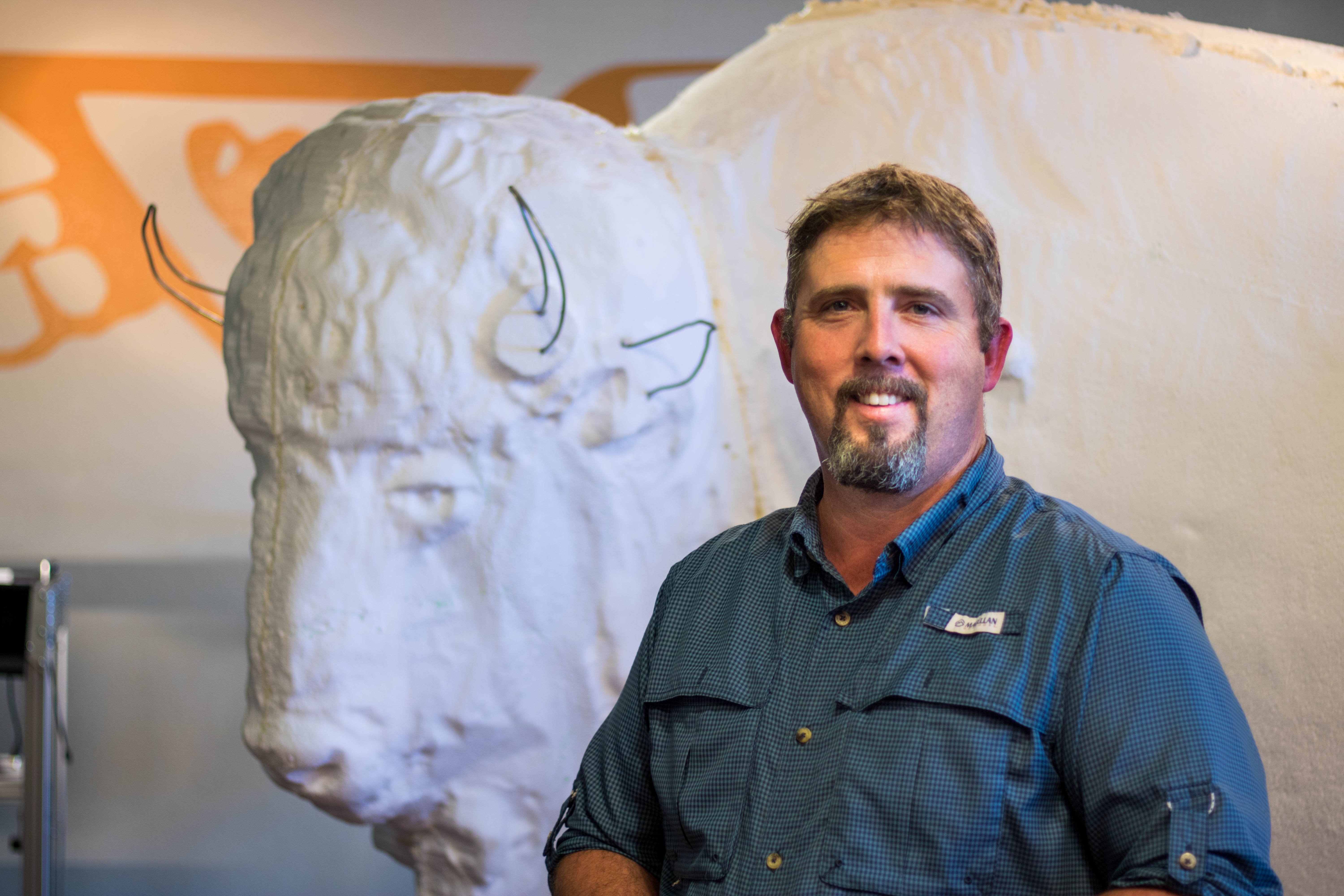
The bronze casting process – called lost-wax casting – is a 5,000+ year old art still being done in the same fashion as it was millennia ago.
“It’s a five generation process,” Clint explains. They start by creating the original sculpture, then making a mold on that sculpture, and then making a wax copy of the sculpture. A ceramic mold is made on the wax copy and flash-fired at 1,700 degrees to melt the wax out – hence the name lost-wax casting. With the wax gone, they’re left with a ceramic vessel that they can pour molten metal into, leaving them with the final sculpture.

Ten years ago, Clint decided that the business needed to start embracing technology.
“At the time, my focus was on 3D laser scanning and CNC milling,” he explains. “We got into the industry by buying a scanner and a huge CNC mill.” They would scan the sculpture and mill it piece by piece out of styrofoam.
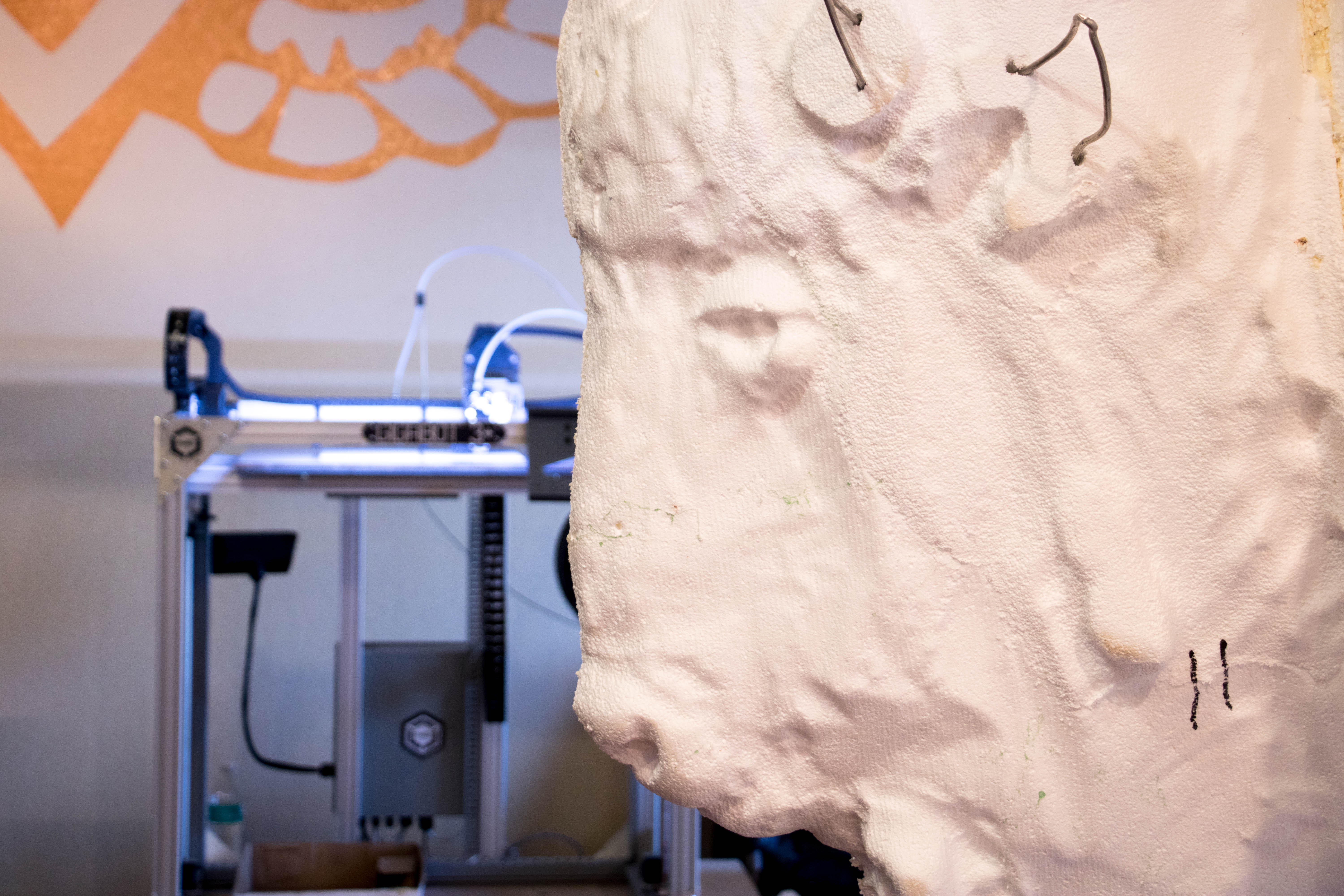
“We did a lot of work for a lot of different artists in this technique,” he recounts, but, as he explained, “you still have to sculpt the whole piece full-size.” Clint describes the process as a huge “paint by numbers.” The styrofoam model gives them the outline and where the detail should be, but they still have to do all the fingerprint detail by hand with clay on top of the styrofoam form.
3D printing really wasn’t on their radar, Clint explains, until several years later.
Life Sized Dinosaurs
Clint got the fateful phone call four years ago from a dinosaur museum in Australia with a project proposal. “They wanted us to produce a herd of dinosaurs and they wanted to prove that it could be done all digitally,” Clint recounts.
The sculptures of the dinosaurs had been modeled in CAD, and the museum wanted Deep in the Heart to 3D print them in a material that could be direct-cast, circumventing “a whole lot of steps” in the casting process, in Clint’s words.

“Of course we had no idea what they were talking about or even where to start,” says Clint, “but they had done the research.” The museum had found Gigabot through Kickstarter and thought it would be an ideal fit given the proximity of the re:3D office to the foundry. “They basically said, ‘We want to do this – how many dinosaurs will this much money get us?’”

Deep in the Heart got their first Gigabot and quickly started experimenting how to best integrate 3D prints into their casting process. They ended up with 14 life-size dinosaurs – a nine-foot-tall, 13-foot-long velociraptor chasing a herd of smaller dinos – which now reside outside the Australian Age of Dinosaurs in Queensland, Australia.
The cost-savings of the project using the new 3D printing method were dramatic.
“To get 14 dinosaurs produced and installed for, let’s say, $120,000,” Clint says, “to do that traditionally – to have sculpted them full scale, to have molded them full-scale, and gone through the traditional lost-wax casting – we would’ve gone triple budget.”

"Unforeseen Benefits"
The dinosaur project was four years ago now, and Clint has since added two more Gigabots to their arsenal. “We bought the second one almost immediately and eventually decided we needed a third one,” he recounts.
Deep in the Heart’s specialty is monumental sculpture: their business is making really large pieces of art. “By having three [Gigabots],” Clint explains, “I can be printing three simultaneously, run them 24 hours a day, and it allows us the capacity to move a bigger piece through quicker.” They could do the job with one machine, he explains, but they want to move faster.

The benefits of incorporating 3D prints into their casting process have been unexpected and multitudinous.
“One of the unforeseen benefits of 3D printing that I really didn’t expect in the beginning is the consistency and thickness that we can generate in the computer is far superior to anything that we can do by by hand,” Clint muses.
The traditional method is less precise: pouring molten wax into a mold and pouring it out, or painting liquid wax onto the surface of a mold. “We’re trying to gauge that thickness by experience; which direction the wind’s blowing that day,” Clint remarks. “I mean, we’re trying and we can get fairly close, but we have variances within our thicknesses.”
This means they’re often using more bronze in a sculpture than is actually necessary – yielding costlier pieces – simply because the wax mold is made by the imperfect human hand.
Replace the wax mold with a 3D printed one, and the thickness is now precisely and uniformly set in the computer. “It’s going to be exactly that consistency through every fold, every detail,” says Clint.

“That really allows us to control our costs,” he comments. It also unexpectedly increased the quality of their casting, because with the 3D prints – as opposed to wax molds – “there’s no movement.”
“Wax is innately flexible,” Clint explains. Large sculptures are cast in many different sections – the massive buffalo they’re currently working on will be 30 or 40 separate pieces – and “each of those sections has the potential to warp slightly.” That means they’re often hammering and muscling the different pieces into alignment when it comes to assembling the final sculpture.
“With the 3D prints, they don’t move. At all.” Clint estimates that the assembly time of a monument that’s been 3D printed is about half that of one cast using wax molds.

The Rule of Three
“Most of the time when a commissioning party is asking for a monument to be made, they’re asking it to be a unique one-of-a-kind,” says Clint.
He explains that 99% of large sculptures out there start their life as a maquette – a miniature version of the big one. “That small maquette is where all the design work happens. It’s where all the artistic creativity happens.” The full-size sculpture is then just a mathematical formula of duplicating the miniature.
“Where 3D printing comes into play,” he explains, “is you don’t have to sculpt it big.”
They can take the small model, whether they sculpted it traditionally and then 3D scanned it, or whether they modeled it directly in the computer using CAD software, and they can print that model full-scale. This cuts out multiple parts of the process: they no longer have to sculpt full-scale, rubber mold full-scale, or make a a full-scale wax copy.

“I mean, you can literally just go straight from the printer into the ceramic shell process, and then you can cast.” The PLA material they print with burns out almost identically to wax, he explains.
It’s a huge time, energy, and cost-savings for them as a foundry. And for the artists, as Clint puts it, it allows them to go big faster. “It also allows artists to be more competitive because there’s not all those steps they’re having to pay for.”
Clint describes the cost savings rule of thumb as a “rule of three.” If a certain piece is going to be produced more than three times, “it might be cost-effective to do it the traditional method of actually sculpting the piece full-scale and making a mold on it,” he says.
“But if it’s going to be produced three times or less,” he explains, “the 3D printing route is cheaper.”
Where History and Technology Melt Together
“The cool thing about what we do is there’s always some historical significance,” explains Clint. “There’s always some story. What we’re doing is more than just an object.”
He’s referring specifically to the foundry’s focus at the time of this visit: a piece called The Splash, which is now installed in Dublin, California.
The sculpture pays homage to the role that a natural spring has played in the growth of the city, dating back to a Native American tribe. “The water is a very integral part of the city’s history,” explains Clint. “It’s also a very integral part of the native Americans that still live there, because the whole reason that this area was settled was because of this spring.”

The piece is 150 feet long: a large fluid-looking figure from which seven splashes emanate. Clint walks through the design: a water spirit has skipped a stone, causing these seven splashes. Each splash has a harmonic frequency superimposed into its face, which, Clint explains, is a “very specific part of the story.”

He goes on to recount that in the 1960s or 70s, the only surviving members of the tribe who still spoke the native tongue passed away. The tribe had lost their language.
In the 90s, anthropologists visited the area with wax cylinder recordings taken by anthropologists in the 1910s and 1920s who visited and recorded their language. “Luckily enough,” Clint goes on, “the elders in the community remembered their grandparents speaking the language enough to be able to help the anthropologists pull the language out of all of these recordings.”

Since this visit in the 90s, the tribe has now rediscovered their native language, and the sound waves on the surface of the bronze splashes pay homage to this.
“What we’ve got in all of these splashes is seven generations of members of the tribe saying ‘Thank you’ to the water spirit,” Clint explains. “That harmonic pattern is their voice frequency that was taken by technology, and then visualized in technology, and then superimposed on this sculpted splash in the computer, and then 3D printed so that each one of those splashes has the fingerprint of the voice of a [generation] of this tribe saying thank you.”

The impact of technology is woven throughout the story, from the rediscovery of the tribe’s native language to the creation of the sculpture to commemorate the role of water in the city’s history.
“It’s amazing,” Clint remarks. “Technology allowed it all to be created in the computer. The piece was 100% sculpted in 3D software and the monument has been 100% 3D printed and cast using the technology.”

Blending Old and New
It’s hard not to draw parallels between Clint’s commentary about the future of bronze casting and The Splash piece which his team produced.
The role of technology is steeped in both narratives. It’s been a tool, an enabler, a key to unlock a language and make a commemoration of that feat come to life.
And yet there can be pushback within the industry, resistance to the introduction of new technology that some see as a threat to the art’s centuries-old roots. “It’s a fine line to keep all of the ancient technology and the ancient techniques, and marry them with all this new stuff,” Clint comments.
But the basic process as the industry knows it is not going away, Clint explains. “We’re still going to have to go through casting the same way,” he says. “What I’m starting to realize in the industry is that the traditional method will probably never die.”
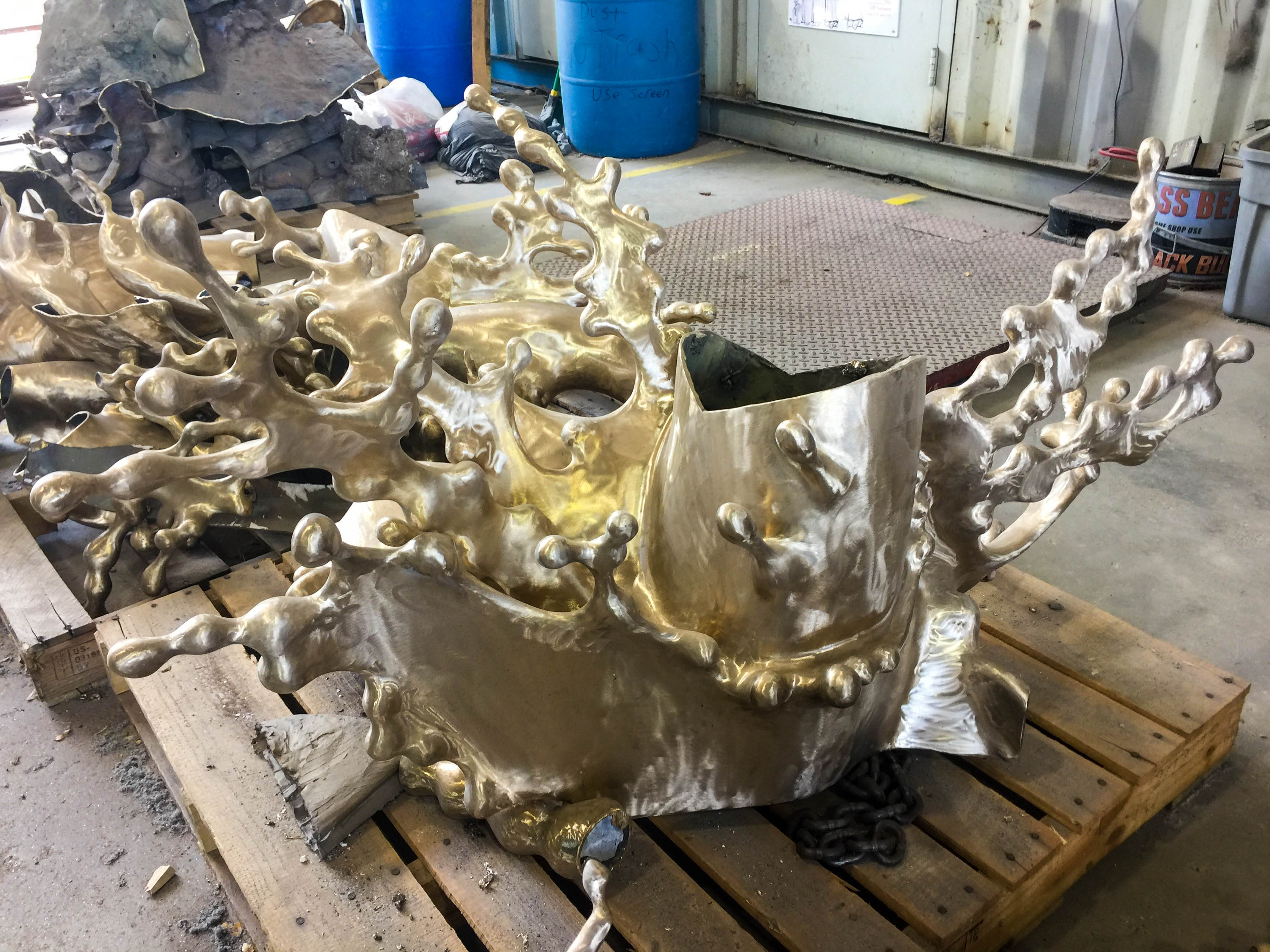
Yes, several steps of the process are replaced by a single 3D print, but the piece still must be sculpted – whether physically or digitally – the bronze still must be poured, the sculpture still assembled and given its artistic hand-touch. The heart of the casting process is still very much there.
“But,” he goes on, “right now, I have probably 6,000 square feet of mold storage. Those molds are susceptible to handling, they’re susceptible to human error, they’re susceptible to just degradation over time.”
He sees a not-so-distance future where molds are obsolete, where a quarter of his floor space suddenly and miraculously becomes free for other use.
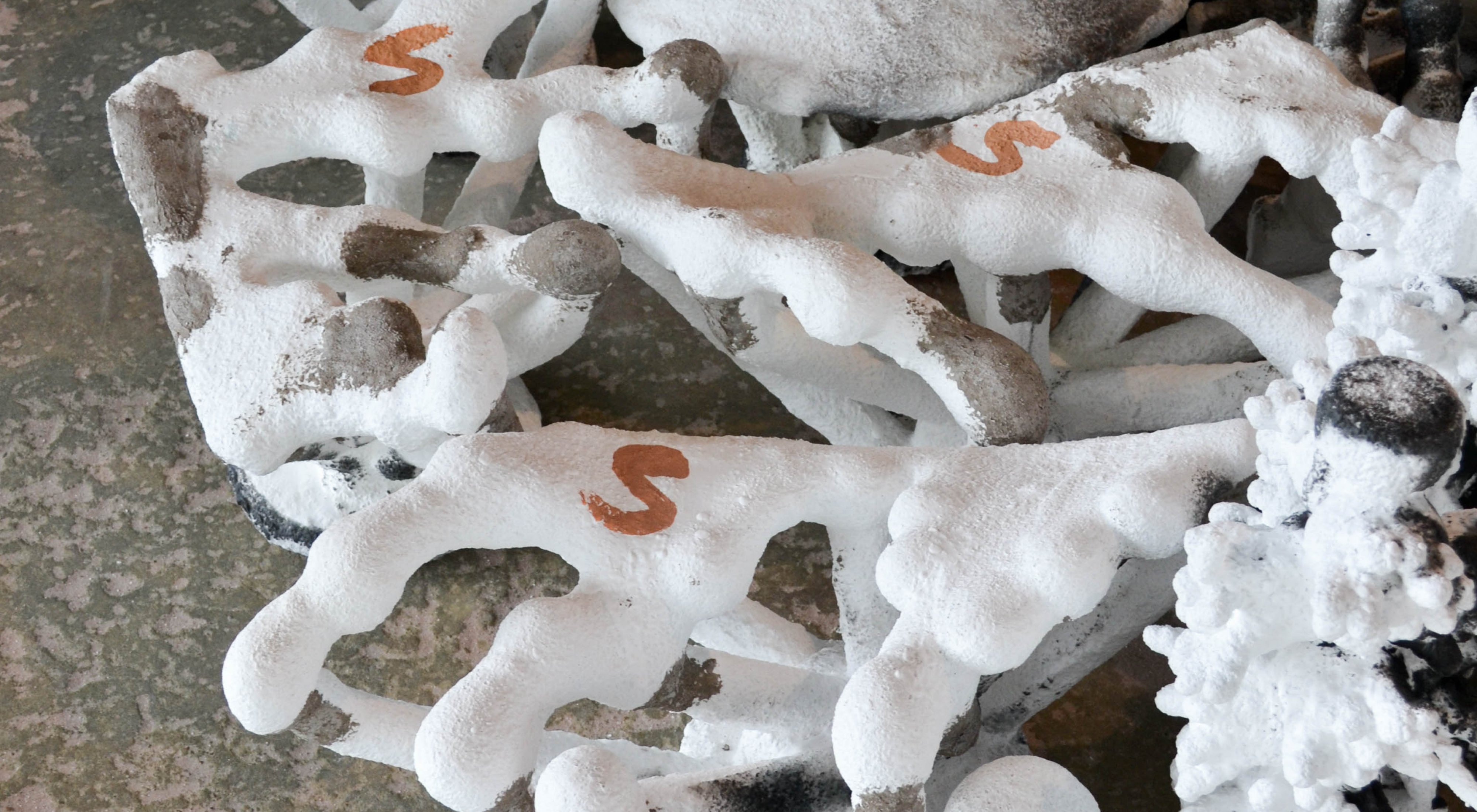
“What the technology is leading me to believe is that very shortly, we’re going to have cloud based servers holding 3D files that represent the mold of the part,” he explains. “And now we can make that part any size we want. We can make it a little tiny miniature for a role playing game, or we can make it a 25-foot-tall monument to go in front of a casino in Vegas.” There’s no need to make a new mold for each varying size of a sculpture – it’s all done digitally – and the only storage space being used is on a hard drive.

Clint’s sights are set on the future, on the next generation of bronze casters.
“The artists that that are coming up and the artists that are going to be doing these monuments in 50 years, they’re all sculpting in the computer right now and they’re playing video games right now and they’re going to embrace that technology and that process.”
Clint has a profound respect for the age-old casting tradition, and he’s also a businessman. It’s his forward-thinking vision and willingness to dive into unknown territory that has helped him grow Deep in the Heart over the last nearly two decades.
“It is an amazing shift, and I definitely think that for the art foundries in the country to stay on top of it, they’re going to have to be embracing this technology and watching what’s happening and paying attention to all of these changes.”
Learn more about Deep in the Heart and their work on their website: https://pyrology.com/portfolio/
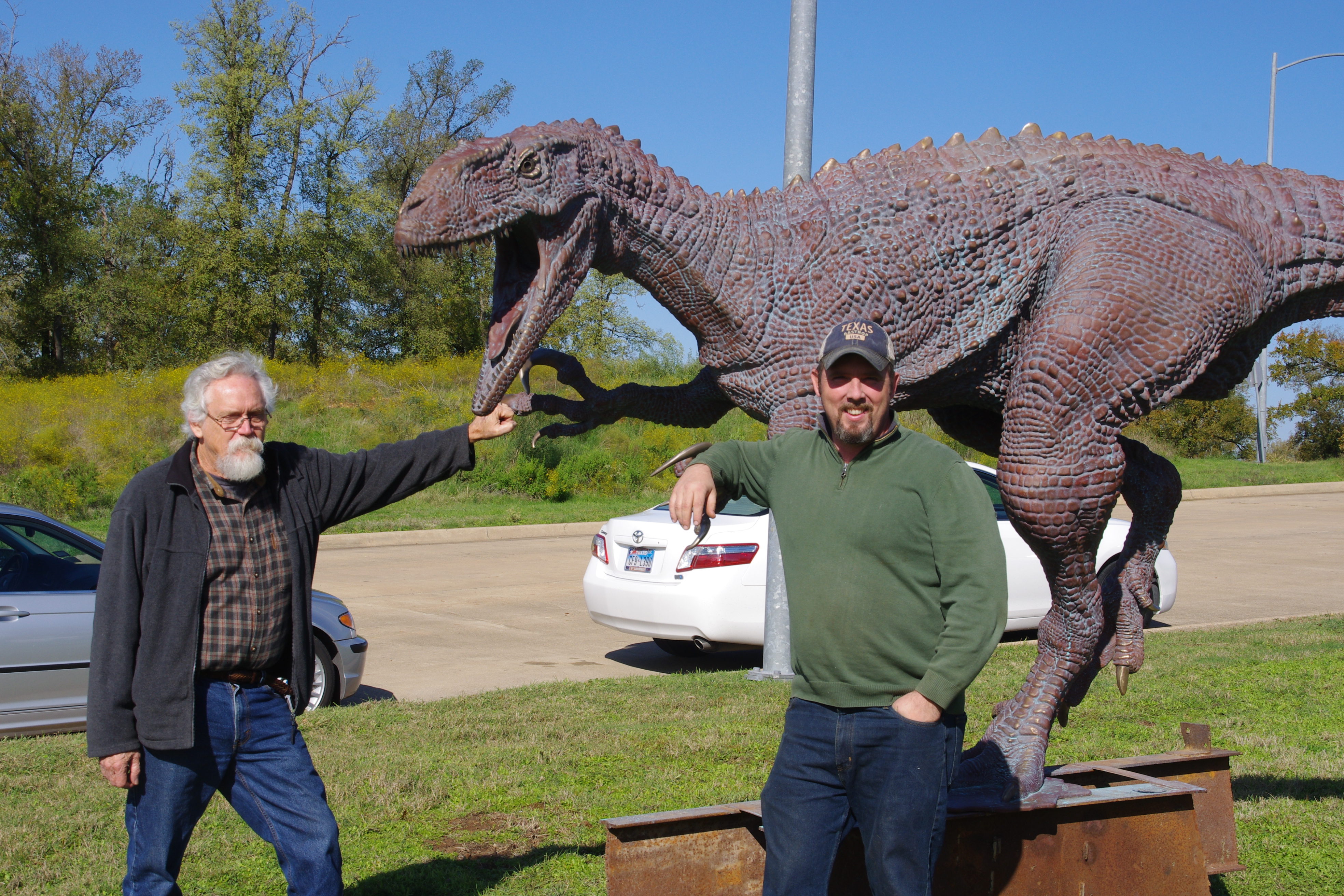
Morgan Hamel
Blog Post Author
Medical Models For Disaster Response: Why We Designed and 3D Printed Flexible Vaginas
Nearly a year ago, Hurricane Maria devastated Puerto Rico with its Category 5 power. The entire electrical grid was destroyed, water systems were inoperable, 95% of cellular sites were broken and 400 miles of Puerto Rico’s 16,700 miles of roads were too damaged to drive on causing thousands of people and communities isolated from communications and disaster relief.
While the island experienced many problems, many problem solvers stepped up to respond and local grassroots relief and recovery efforts formed immediately. One local organization, Colectiva Feminista en Construccion – a political organization advocating for women’s rights and protesting capitalistic and patriarchal oppression– opened up a fund and set up a center in an abandoned building in San Juan to distribute supplies to the community. But they didn’t stop there.“We don’t want to be just a band-aid,” shared one of the organizers, Maricarmen Rodriguez, “We want to help everyone and create a more inclusive society. Hurricane Maria cleared the makeup that was covering up problems that were already in Puerto Rico.”
One of those problems surfaced while providing feminine hygiene products and realizing the need for medical models to teach about aspects of the vagina and how to use products like Diva Cups. More than that, Maricarmen wanted to find a way to talk about menstrual cups and sexual education that is often taboo in society.
Could 3D printed vaginas be a tool for more grassroots sexual education?
When you look for your typical sex ed class medical models, they can cost hundreds per piece and the industry is monopolized by a small number of manufacturers. These models are made from unforgiving plastics that lack usability and plasticity to use to demonstrate with products like Diva Cups. Not to mention, in post-hurricane conditions, importing products like these would have been nearly impossible and taken months to arrive.

So Maricarmen reached out to re:3D in Puerto Rico and our teammate Alessandra set out to 3D print vaginas.
Right now, there are no open source vagina medical models so Alessandra started from scratch by creating a 2D picture by tracing from a medical book. She then used Rhino to create a 3D model.
The 3D printed vaginas – printed from flexible materials such as Ninjaflex and semi Flex making them more durable and less likely to break – provide more realistic and life-like medical models.
These 3D printed medical models have the ability to be just as realistic with attention to detail at a fraction of the cost: only $20-30 per print. The prints took about 3 hours on Gigabot – making body parts accessible nearly on demand.
This opens up new possibilities for schools, hospitals, and grassroots organizations to have access to affordable teaching tools – before a disaster and to aid in recovery and education after and beyond.

Watch the 1-minute video of Alessandra explaining the 3D printed vaginas
re:3D had a #HurricaneStrong year in 2017 – our Houston team was hit by Harvey and our team in Puerto Rico withstood Hurricane Irma and Hurricane Maria. June 1st marks the official beginning of hurricane season in Puerto Rico and in this series, we are highlighting stories of impact and insight to encourage #3DPrintedPreparedness this year.
Cat George
Blog Post Author

